
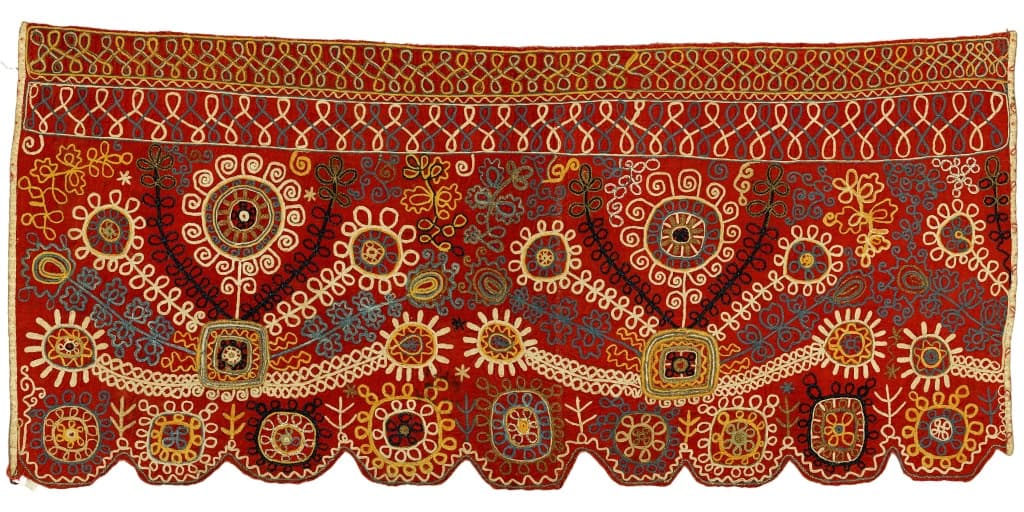
The end of the towel. Kostroma Province. The middle of the XIX century. Kumach, calico, cotton thread, wool thread, gold thread; "tambour" embroidery
Museums have always been keepers of memory. Especially museums of arts and crafts, "the closest art," as art historian Alexander Borisovich Saltykov wrote. The collection of the All-Russian Decorative Art Museum contains art objects that reflected their time, the code of memory of national Russian culture. For a variety of reasons, many of the museum's collections, sometimes for decades, have been waiting to meet their viewers. Many of those who stood at the origins of the discovery of these artifacts, who kept and studied them, who wrote talented articles and books about them, are no longer in the museum. Today we are launching a new project called "Forgotten Collections. It is dedicated to objects, events, fates and discoveries related to the history of museum collections. A series of stories about the appearance of new exhibits, based on past events, memories, and long-written articles. And we will start with one of the most significant collection, which turned out to be in our museum - the collection of artistic textiles of the XVII - early XX centuries by Natalia Leonidovna Shabelskaya.
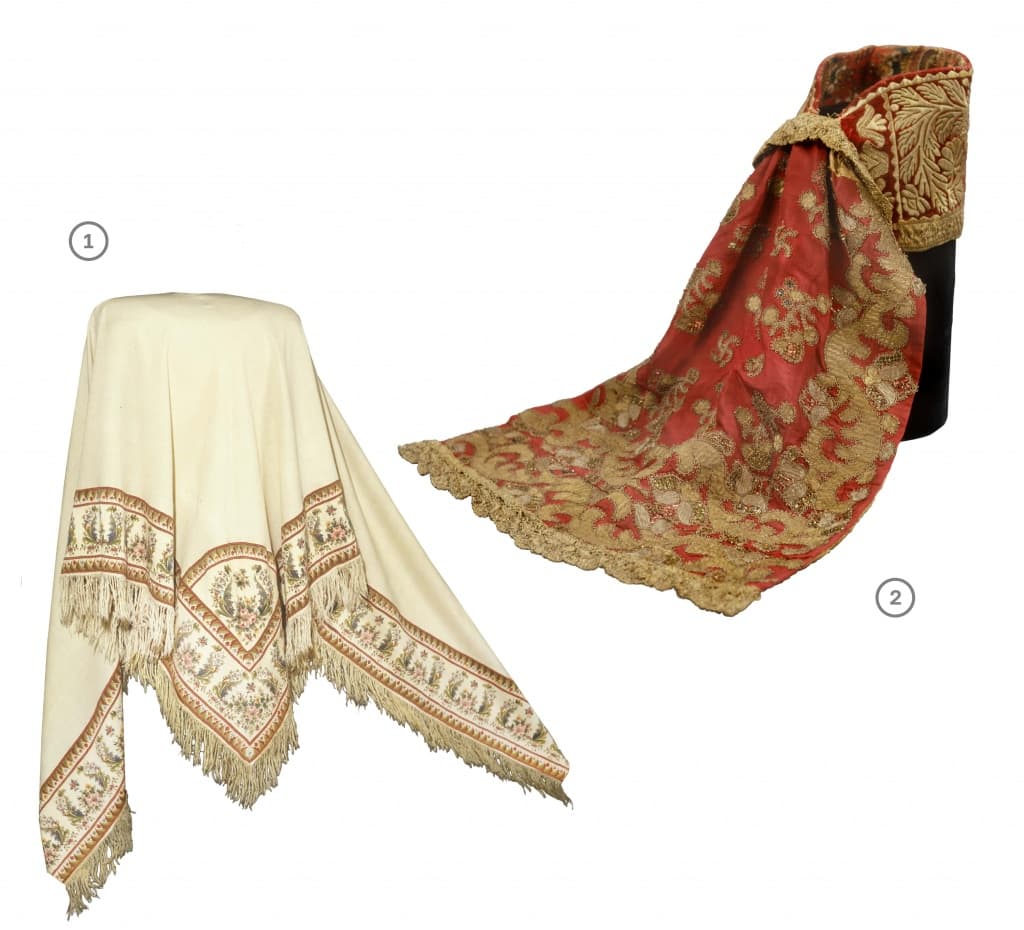
1. Half of a shawl. Saratov Province (?). Manufacture D. Kolokoltsov (?). 1830s. Wool; hand weaving. 2. Maiden's headdress. Nizhny Novgorod Province. 19th century. Velvet, silk, chintz, calico, garter, metallic lace, foil, gold thread, embroidery.
"Sometimes a miracle happens, and monuments that seem to have gone forever into obscurity come back." That is what the newspapers wrote in October 1991 about the return of the most valuable exhibits to their homeland. About the generous gift made by Pavel Mikhailovich Tolstoy-Miloslavsky, who recently came to Moscow from Paris to donate the once famous and forgotten Shabelskys collection to the Russian Decorative Art Museum: "The objects of Russian antiquity have to be back in Russian land”. Savely Yamshchikov, a famous art historian and restorer, who did much to bring the collection back to Russia, recalled his meetings with Tolstoy-Miloslavsky: "I saw the best features of the Russian character: nobility, intelligence, a desire to help others, and most importantly - the pride for their Fatherland and willingness to share its hard fate.
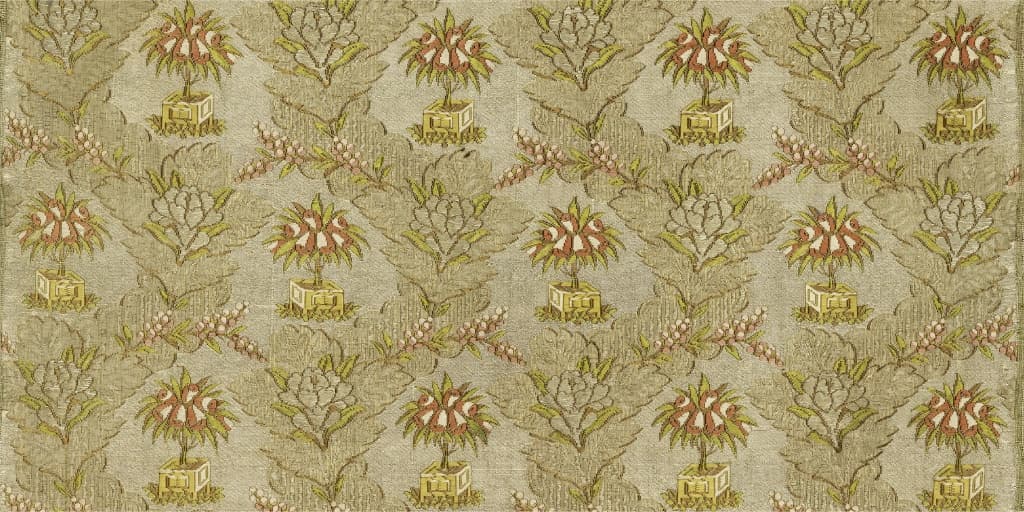
Silk fabric fragment. France (?), Russia (?). Mid XVIII century. Silk, gold thread; weaving.
The happy fate and nobility of Tolstoy-Miloslavsky's decision allowed the Shabelsky collection to return to their homeland. These are wonderful fine lace of the XVIII century, kokoshnikas embroidered with pearls, shawls of silver and gold embroidery. Wonderful sundresses of Catherine II time, lots of samples of weaving, embroidery of XVII-XIX centuries, garter and belts, kichki and browbands, more than a hundred samples of foreign fabrics collected in Russia. The items retained old labels indicating their origin: Vyatka province, Nizhny Novgorod, Torzhok, Arkhangelsk - this part of the scientific collection, familiar to few specialists, became part of the collection of the All-Russian Decorative Art Museum.

1. Sarafan from the collection of N.L.Shabelskaya. Russia. The second half of the XVII century. Silk, cotton fabric, lace, metal buttons, metal lace, metal cord, braid. 2. Woman's festive costume (shirt, sarafan, epanechka). Nizhny Novgorod Province. The end of the 18th - first half of the XIX century.
Unfortunately, not much information has been preserved about the life of Natalia Shabelskaya, the owner of Russia's largest collection of XVII - early XX century art. Although her name is comparable with the names of Pavel Tretyakov, Peter Shchukin, Alexei Bakhrushin. Her contribution to Russian culture is enormous: she gathered a unique collection of folk costumes, headdresses, embroidery, as well as bone, ceramic and wooden items, jewelry of Russians, Karelians, Crimean Tatars, the peoples of the Volga region.

1. The end of the towel. Russia. The end of the XVIII century. Silk, silver thread, gold thread, bobbin thread, silk ribbon, foil; embroidery, bobbin weaving. 2. Fragment of silk fabric - grodetur. Manufacture of Milutin. Moscow. 1796. Silk; weaving.
"Natalia Leonidovna Shabelskaya was one of the most remarkable Russian women of our time. Her original independent activity left a significant mark," wrote the famous art critic Vladimir Stasov.

Fragment of a shawl. Saratov Province. (?). Manufacture of D. Kolokoltsov (?). 1830s. Wool; hand weaving.
The Shabelskys' entire collection was first shown to the public in 1892 at an exhibition in St. Petersburg. Stasov wrote in his article: "Everything in this exhibition delights me: a collection of excellent works done by an ancient Russian woman and an extraordinary knowledge on behalf a modern Russian woman as well as an extraordinary energy of a collector... Natalia Shabelskaya belongs to that generation of women who not only already live an intellectual life, but in addition clearly feel what our nationality is and passionately love it. The exhibition had about 4,000 items. A catalog of almost 100 printed pages testified to the richness and diversity of the collection.
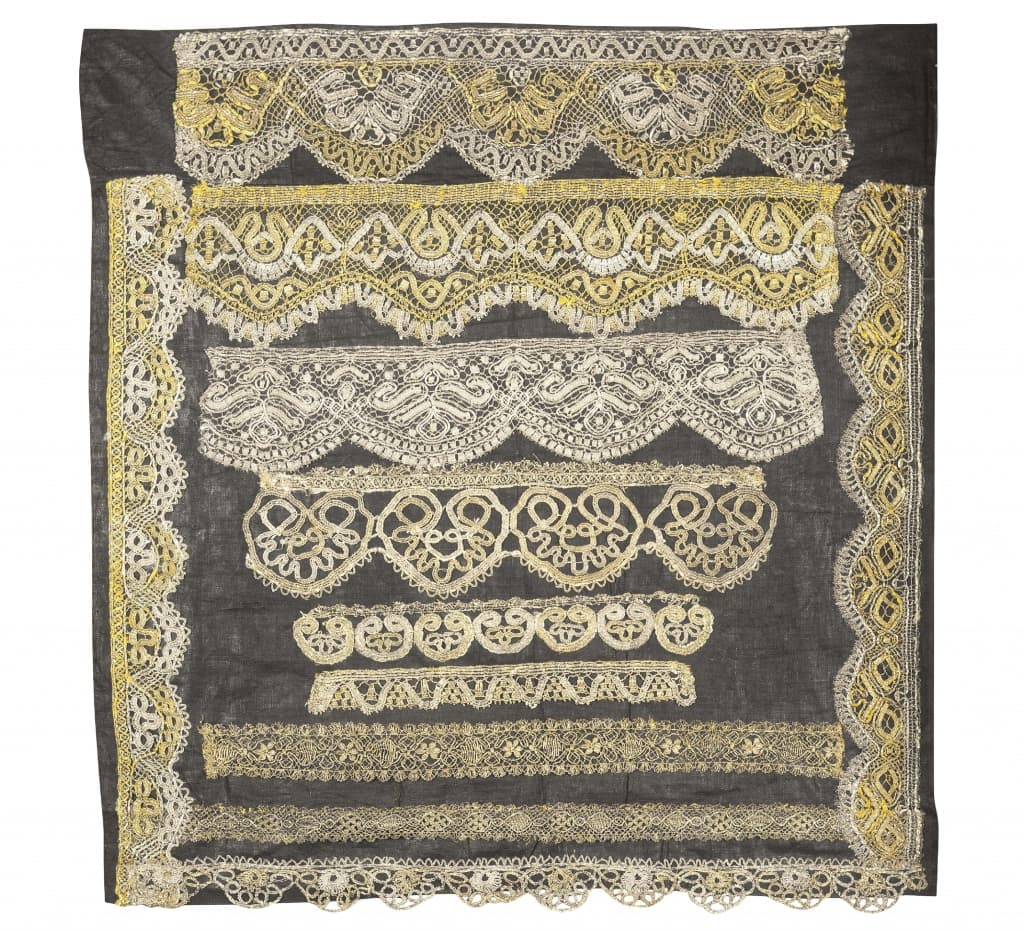
A cloth from N.L.Shabelskaya's exposition of the late 19th-early 20th century with samples of Russian gold and silver lace of the XVII century
Because of Natalia Leonidovna's poor health the family had to live abroad for a long time, where they took the greater part of their collection to be displayed at international exhibitions. "Everywhere she had the greatest success and aroused universal amazement and rapturous praise for her original national collection...".
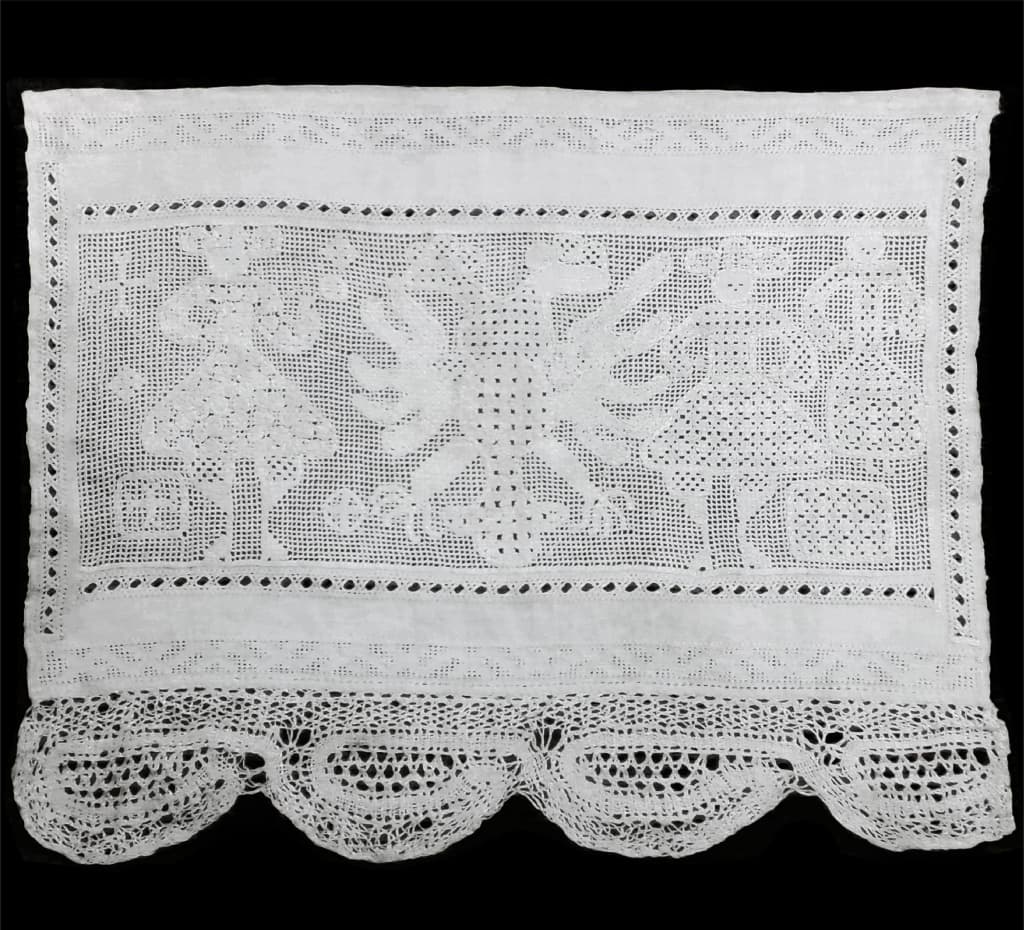
The end of the towel. Russia. End of XVIII century. Flax, cotton thread, bobbin lace; "white stitch" embroidery.
The long stay of the priceless collection abroad troubled Vladimir Stasov and other representatives of Russian culture. And Natalia Leonidovna herself understood that such a significant collection should be in her homeland. She died in January 1904 in Nice, where she was buried. The collection, which already contained over 20,000 objects, was passed on to her daughters. They returned to Russia and in 1906 negotiated the transfer of the collection to the Russian Museum. As a result of the negotiations, some of the items were donated, while others were sold to the ethnographic department of the Russian Museum. In memory of their mother, the sisters began to publish the collected materials. In 1910, the first and only issue of the "Collection of Russian antiquities" was published. The objects remaining in the property of the Shabelskys constituted a complete, well-chosen collection, numbering probably more than 1,000 items. Before the war in 1914, this collection was sent to an exhibition in London and then transported to Nice, where it was kept for about 40 years.
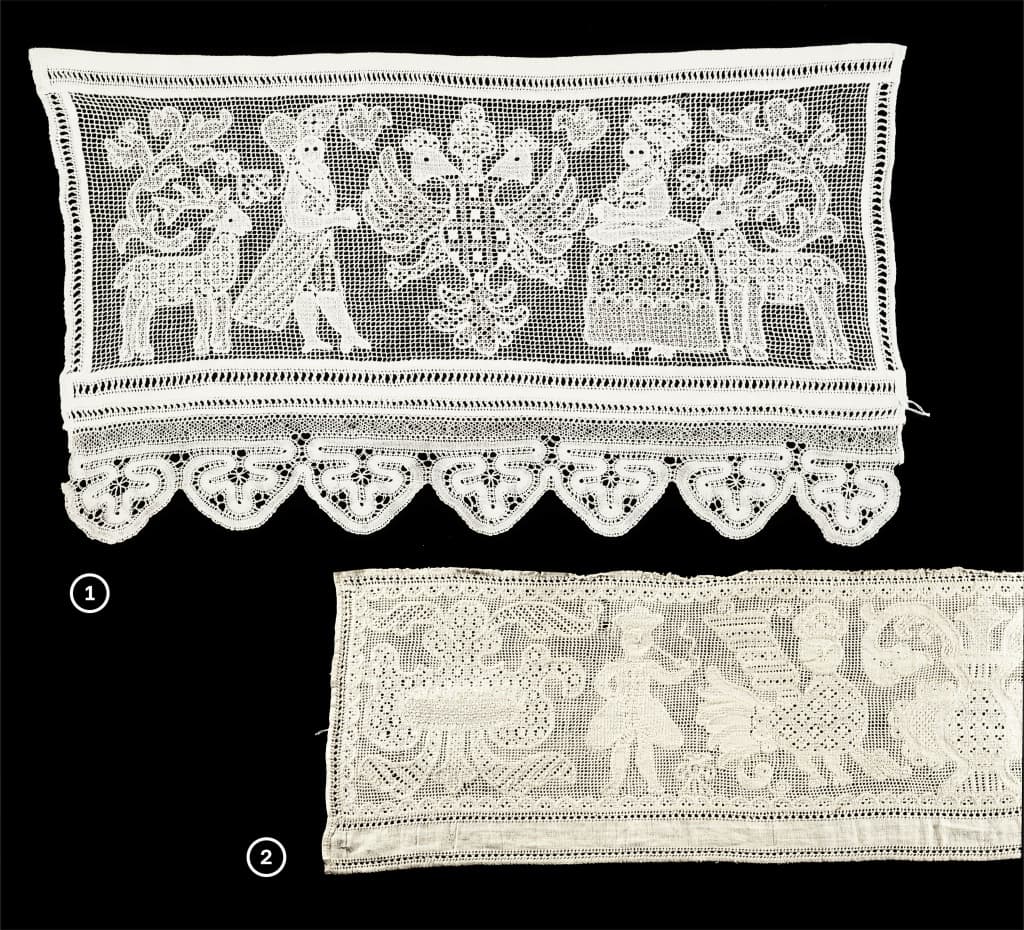
1. The end of the towel. Vologda Province. XVIII century. Linen, cotton thread, bobbin lace; embroidery on the grid, tracery. 2. Podzor (fragment). Russia. The end of XVIII century. Linen, linen thread, "white stitch" embroidery.
After the revolution, the Shabelsky sisters linked their lives professionally with "antiquity", becoming restorers in the central state workshops under the guidance of Igor Emmanuilovich Grabar. In 1925 they left for France, first for Paris, then for Nice. They earned their living by sewing, restoration, making straw hats ("everyone goes crazy about them"). Gradually, many of the remaining pieces in the collection pass into private and public hands.
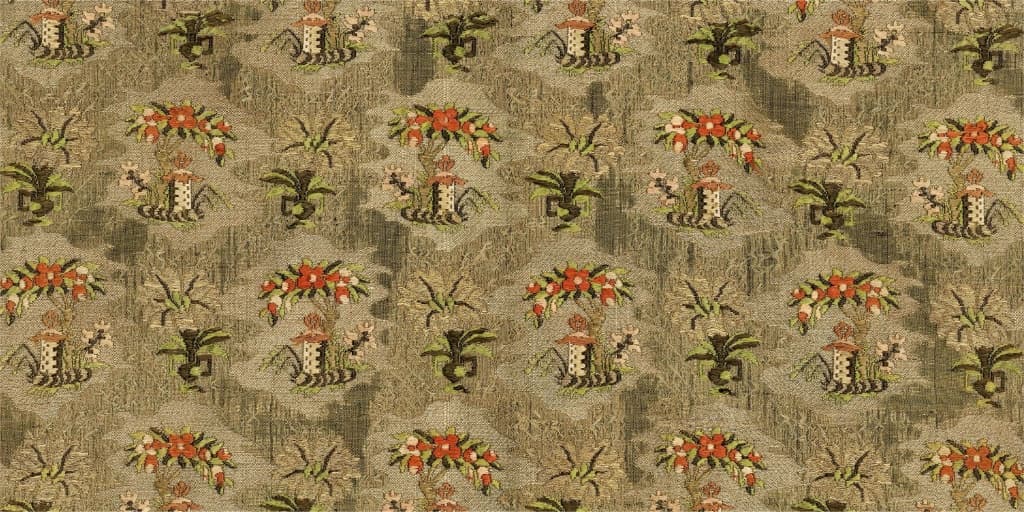
Brocade sample. Russia. The middle of the XVIII century. Silk, gold thread, silver thread; weaving.
After the death of the Shabelsky sisters during the Second World War, it was Leonid Adamovich Pyanovsky, former secretary of the sisters, who became the last owner of the rest of the collection. In the 50s, it was announced that the collection would go on sale. The question of acquiring this part of the Shabelsky collection and returning it to their homeland was raised in the USSR. "Now, at last, there is an opportunity to return this unique collection to the Russian people." But at the time, the return of the collection never took place. Pyanovsky was very much afraid that the bequests would fall into random hands, and only before his death there came a man who could buy from him a part of the exhibits of the once famous collection. The Russian emigrant and Paris resident, Pavel Mikhailovich Tolstoy-Miloslavsky has carefully preserved the items, photographs and an edition of "Russian antiquities collection" of 1910 and donated them to our museum in 1991.
This is how fate fulfilled the cherished dream of the remarkable connoisseurs of Russian antiquities Varvara and Natalia Shabelsky.
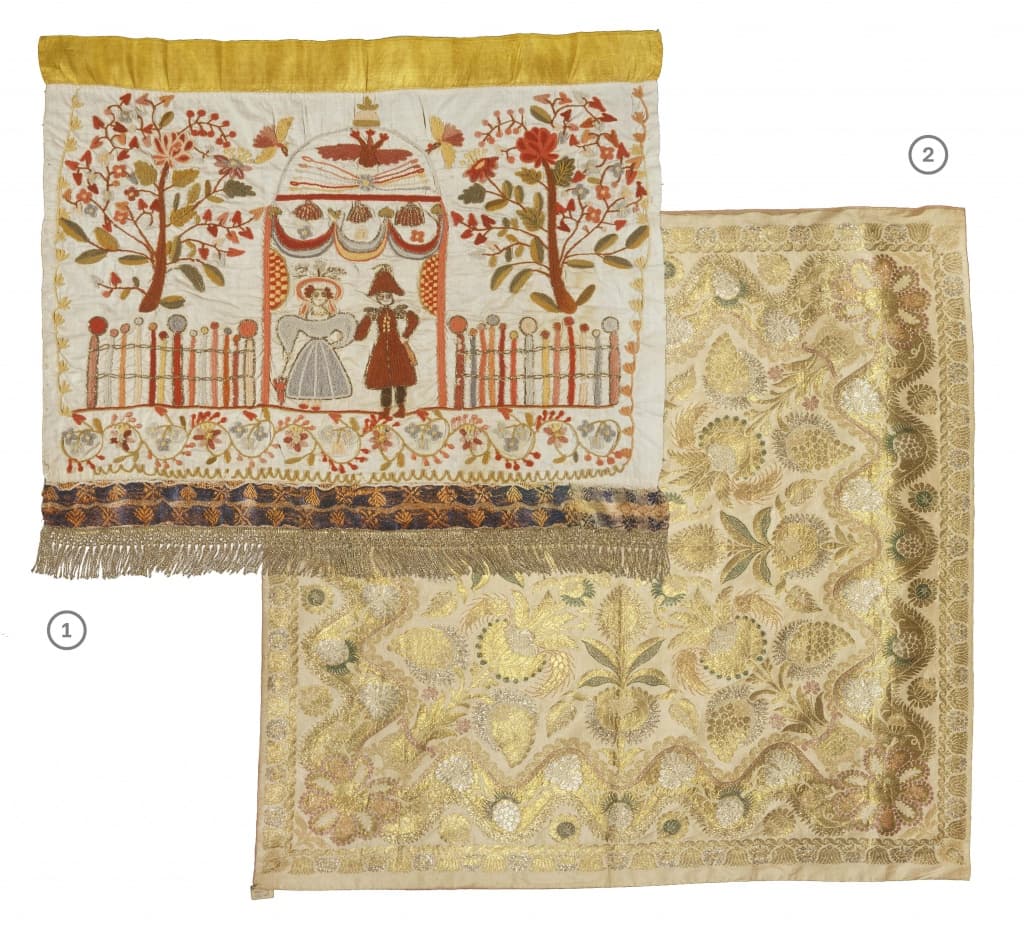
1. The end of the towel. Kostroma Province. 1830s. Mitkal, silk ribbons, silver fringe, braid, wool thread, metal thread; embroidery "tambour". 2. Brocade shawl. Russia. End of the XVIII century. Silk, gold thread, silver thread; weaving.



